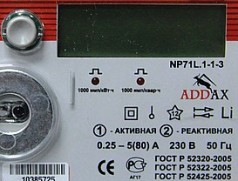Categories: Featured Articles » Novice electricians
Number of views: 66725
Comments on the article: 15
Is reactive electricity available?
 For power engineers of enterprises and large shopping centers, there is no doubt that reactive energy exists. Monthly bills and quite real money that goes to pay reactive electricity, convince of the reality of its existence. But some electrical engineers seriously, with mathematical calculations, prove that this type of electricity is fiction, that the separation of electric energy into active and reactive components is artificial.
For power engineers of enterprises and large shopping centers, there is no doubt that reactive energy exists. Monthly bills and quite real money that goes to pay reactive electricity, convince of the reality of its existence. But some electrical engineers seriously, with mathematical calculations, prove that this type of electricity is fiction, that the separation of electric energy into active and reactive components is artificial.
Let's try and we will sort this issue out, especially since the creators speculate on ignorance of the differences between different types of electricity “Unique” and “revolutionary” energy-saving devices. Promising huge interest energy saving, they knowingly or unknowingly replace one type of electrical energy with another.
Let's start with the concepts of active and reactive electricity. Without going into the jungle of formulas of electrical engineering, you can determine active energy as the one that does the work: heats food on electric stoves, illuminates your room, cools the air using an air conditioner. And jet electricity creates the necessary conditions for such work. There will be no reactive energy, and the engines will not be able to rotate, the refrigerator will not work. The voltage of 220 volts will not come into your premises, since no power transformer can operate without the consumption of reactive electricity.
If the current and voltage signals are simultaneously observed on an oscilloscope, then these two sinusoids always have a shift relative to each other by an amount called phase angle. This shift characterizes the contribution of reactive energy to the total energy consumed by the load. By measuring only the current in the load, it is impossible to isolate the reactive part of the energy.
Given that reactive energy does not do work, it can be generated at the place of consumption. For this, capacitors are used. The fact is that coils and capacitors consume various types of reactive energy: inductive and capacitive, respectively. They shift the current curve with respect to voltage in opposite directions.
Due to these circumstances a capacitor can be considered a consumer of capacitive energy or an inductive generator. For a motor that consumes inductive energy, a nearby capacitor can become its source. Such reversibility is possible only for reactive circuit elements that do not perform work. For active energy, such a reversibility does not exist: its generation is associated with fuel costs. After all, before you complete the work, you need to spend energy.
In domestic conditions, power transmission organizations do not charge a fee for reactive energy, and a household meter only considers the active component of electrical energy. A completely different situation at large enterprises: a large number of electric motors, welding machines and transformers, which require reactive energy to operate, create an additional load on the power lines. In this case, the current increases and the heat loss of already active energy.
In these cases, the consumption of reactive energy is taken into account by the meter and is paid separately. The cost of reactive electricity is less than the cost of active, but with large volumes of its consumption, payments can be very significant. In addition, fines are imposed for the consumption of reactive energy in excess of the agreed values. Therefore, the generation of such energy at the place of its consumption becomes economically beneficial for such enterprises.
To do this, either individual capacitors or automatic compensation units are used, which monitor the volume of consumption and connect or disconnect capacitor banks. Modern compensation systems significantly reduce the consumption of reactive energy from an external network.
Returning to the question in the title of the article, we can answer it in the affirmative. Reactive energy exists. Without it, the operation of electrical installations in which a magnetic field is created is impossible. Not committing visible work, it is, nevertheless, a prerequisite for performing work performed by active electric energy.
See also: Options for reactive energy compensation in the home using the Saving Box
See also at e.imadeself.com
:
